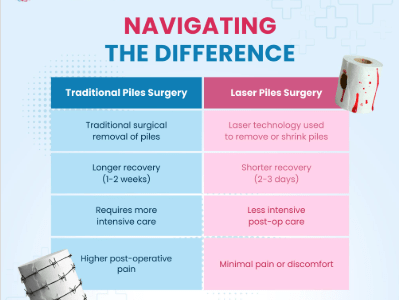Millions of people suffer from piles, also known as hemorrhoids, a common but extremely uncomfortable condition. Even though it’s frequently associated with lifestyle choices like heavy lifting, extended sitting, or pregnancy, the discomfort can change a person’s life if left untreated. Even though piles surgery is sometimes viewed with skepticism, it provides a remarkably effective solution to chronic hemorrhoidal issues, resulting in long-lasting relief and a significantly enhanced quality of life.

Depending on the type and severity of hemorrhoids a person has, piles surgery can range from hemorrhoidectomy to stapled hemorrhoidopexy. Prolapse, thrombosis, and recurrent or persistent hemorrhoids are just a few of the many complications that the procedure treats. Modern piles surgeries are remarkably adaptable and successful due to advancements in medical technology, guaranteeing a speedy recovery and prompt alleviation of symptoms like pain, itching, and bleeding.
The only way to fully remove hemorrhoids and put an end to persistent pain and annoyance for many people is through surgery. For patients who have tried every other treatment, piles surgery is a very dependable option because the long-term advantages of the procedure greatly exceed the short-term discomfort.
Why Surgery for Piles May Be Your Best Option
The key to reducing the pain and complications related to hemorrhoids is knowing when to choose surgery. Surgery is required for people with severe or recurring hemorrhoids, even though many can be controlled with topical medications, lifestyle modifications, or minimally invasive techniques like rubber band ligation.
For instance, because prolapsed hemorrhoids protrude from the anus and are challenging to reposition, they frequently cause severe pain. As the condition worsens over time, surgical intervention—such as a hemorrhoidectomy—may be necessary to completely remove the prolapsed tissue.
However, thrombosed hemorrhoids can cause excruciating pain. The hemorrhoid’s circulation is cut off by the blood clot inside it, which causes swelling and, in rare instances, rupture and severe bleeding. Because surgery removes the clot and repairs the damaged tissue, it can provide relief right away.
The most dangerous consequence for some people is strangulated hemorrhoids. Hemorrhoids may die if they are trapped and cut off from the blood supply, which would result in irreversible tissue damage and a higher risk of infection. In these situations, surgery is necessary to avoid serious outcomes.
Understanding the Types of Piles Surgery
| Surgical Procedure | Description | Recovery Time |
|---|---|---|
| Hemorrhoidectomy | The complete removal of hemorrhoids, typically used for the most severe cases, such as thrombosed or prolapsed hemorrhoids. | Recovery typically takes between 2 to 8 weeks, depending on the severity and individual healing. |
| Stapled Hemorrhoidopexy | A minimally invasive method to reposition the hemorrhoids and staple them back inside the anus, avoiding full excision. | Recovery is quicker, usually around 1 to 2 weeks, with less pain and a reduced risk of complications. |
| Hemorrhoidal Artery Ligation | A procedure that involves cutting off the blood supply to the hemorrhoids, causing them to shrink over time. | Recovery usually takes 1 week, and patients generally experience less pain than other methods. |
The Road to Recovery: Post-Surgery Expectations
The length of recovery following piles surgery varies based on the procedure type and the patient’s general health. The recovery phase can be difficult, even though the actual surgical procedures are rather simple. Although modern techniques have significantly reduced recovery time and discomfort compared to older methods, patients should still expect pain and discomfort, particularly in the first few days after the surgery.
Following surgery, patients frequently experience some bleeding, bruising, and swelling. Over time, though, these symptoms ought to get better. Within a few days, many patients report feeling much better, and after one to two weeks, they are able to resume their jobs. It usually takes two to eight weeks for patients to fully recover, during which time they should refrain from heavy lifting and physically demanding activities.
Postoperative care is essential for a speedy recovery after surgery. To avoid constipation, patients are encouraged to eat a diet high in fiber, stay hydrated, and follow a regular bowel schedule. This preventative measure can lower the chance of complications and greatly improve healing.
Why Take a Look at Piles Surgery?
Surgery provides a long-term solution for people with chronic hemorrhoids by addressing the underlying cause of their discomfort. Pile surgery offers a route to real healing, regardless of the throbbing pain of thrombosis or the humiliation and annoyance of prolapsed hemorrhoids. For individuals seeking to restore their quality of life and permanently eliminate hemorrhoidal pain, piles surgery is highly dependable due to its high success rate and demonstrated efficacy.
As always, the best course of action for your particular condition depends on speaking with a healthcare professional. Patients can be confident that the latest developments in piles surgery will provide them with long-lasting relief and a healthier future, regardless of whether they choose hemorrhoidectomy, stapled hemorrhoidopexy, or another surgical technique.
